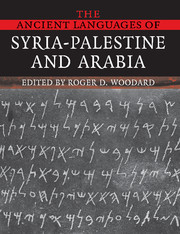Book contents
- Frontmatter
- Contents
- List of figures
- List of tables
- List of maps
- List of contributors
- Notes on numbering and cross-referencing
- List of abbreviations
- Preface
- Preface to the first edition
- Map
- 1 Language in ancient Syria-Palestine and Arabia: an introduction
- 2 Ugaritic
- 3 Hebrew
- 4 Phoenician and Punic
- 5 Canaanite dialects
- 6 Aramaic
- 7 Ancient South Arabian
- 8 Ancient North Arabian
- Appendix 1 Afro-Asiatic
- Appendix 2 Full tables of contents from The Cambridge Encyclopedia of the World's Ancient Languages, and from the other volumes in the paperback series
- Index of general subjects
- Index of grammar and linguistics
- Index of languages
- Index of named linguistic laws and principles
2 - Ugaritic
Published online by Cambridge University Press: 22 September 2009
- Frontmatter
- Contents
- List of figures
- List of tables
- List of maps
- List of contributors
- Notes on numbering and cross-referencing
- List of abbreviations
- Preface
- Preface to the first edition
- Map
- 1 Language in ancient Syria-Palestine and Arabia: an introduction
- 2 Ugaritic
- 3 Hebrew
- 4 Phoenician and Punic
- 5 Canaanite dialects
- 6 Aramaic
- 7 Ancient South Arabian
- 8 Ancient North Arabian
- Appendix 1 Afro-Asiatic
- Appendix 2 Full tables of contents from The Cambridge Encyclopedia of the World's Ancient Languages, and from the other volumes in the paperback series
- Index of general subjects
- Index of grammar and linguistics
- Index of languages
- Index of named linguistic laws and principles
Summary
HISTORICAL AND CULTURAL CONTEXTS
Ugaritic is the only well-attested example known today of the West Semitic languages spoken in the Levantine area in the second millennium BC. The position of Ugaritic among the Semitic languages has been a matter of dispute, in part because of a confusion of categories, namely between literary and linguistic criteria. Literarily, the poetic texts show strong formal (poetic parallelism), lexical, and thematic affinities with Biblical Hebrew poetry. Linguistically, however, Ugaritic is considerably more archaic than any of the well-attested Northwest Semitic languages, and probably descends directly from a Levantine “Amorite” dialect. All indications are that it is not more directly related to East Semitic (Akkadian) than to West Semitic. Within the latter branch, it shares certain important isoglosses with Northwest Semitic as opposed to Arabic (e.g., roots Iw → Iy) and with Canaanite as opposed to Aramaic (e.g., /ḍ/ → /ṣ/). The isoglosses shared with Arabic (e.g., consonantal inventory) represent for the most part features commonly inherited from Proto-Semitic.
Ugaritic is a one-period language, attested only for the last part of the Late Bronze Age, approximately 1300–1190 BC. This is because the writing system in which known Ugaritic texts are inscribed was not invented (at least according to present data) until the early thirteenth century, whereas the city of Ugarit – virtually the only site where Ugaritic texts have been discovered – was destroyed early in the twelfth century.
- Type
- Chapter
- Information
- The Ancient Languages of Syria-Palestine and Arabia , pp. 5 - 35Publisher: Cambridge University PressPrint publication year: 2008
- 2
- Cited by

